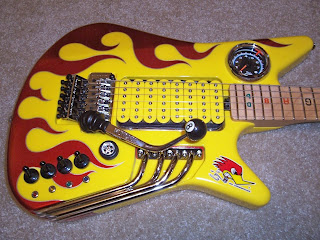For extra percussive crunch and resonance control, both pickup positions are internally backed with nitrocellulose lacquered Honduran mahogany chambers. These innovative chambers are designed for high overdrive hard rock players, and provide excellent feedback control, with a warm hybrid-blend of aluminum resonance through Mahogany.
By simply removing the 4 screws of each pickup ring during a string change, the center portions of these chambers can be removed. Removal of these Mahogany chamber “plugs” allows the arch-top to attain its fullest potential: for a deep, infinite sustain under overdriven conditions, and a rich array of crystal-clear low and high tones that no other instruments can naturally achieve. Our Alnico ‘V’ humbuckers are slightly over-wound and balanced specifically for classic to heavy rock for chambered guitars.Classic-59 type windings are available and recommended for non chambered bodies for Jazz, Blues, Classic rock and Fusion type players.
The incredibly versatile 1100-Custom Guitar can be customized with optional pickups wired with detachable micro plugs. AlumiSonic provides all commercially available pickups, with a micro plug pre-installed for easy changeability.
Custom Warmoth necks are offered for the 1100-Custom, and are designed to maintain the feel, balance and temperature of a classic, set neck carved-top instrument. Through extensive testing we determined that mahogany is the necessary hybrid ingredient for balance of flavoring, and transference of sound from a quality tone wood neck, to a pure aluminum body. The neck is internally mounted with our patented AlumiSonic Set Neck Mounting System which results in a smooth back with no external neck mounting hardware. This new and innovative mounting method also allows for better tone transfer from neck to body than ordinary neck mounting methods. In addition to providing a stronger connection than ordinary bolt- on necks, the Set Neck is easily replaceable in case of damage. 1100-Custom neck pockets are angled back at a traditional 5 degrees for perfect “Tun-O-Matic” bridge alignment and action, or for the Stetsbar Pro II Tremolo.
The 1100-Custom is the ultimate marriage of three acoustically tuned materials: 1100 aluminum for deep sustain and resonance, 6061 aluminum for clarity and crystalline overtones, and mahogany for that classic warmth and feel. All three materials make for a wicked combination of simultaneously identifiable sounds. The 1100-Custom Guitar is undeniably the finest aluminum hybrid instrument ever created.
| Taken from Alumisonic |





























